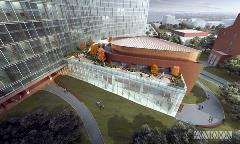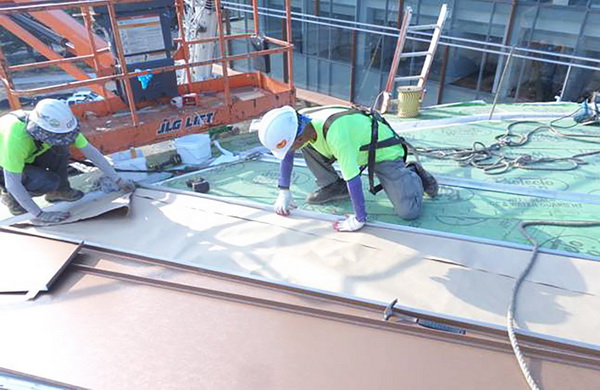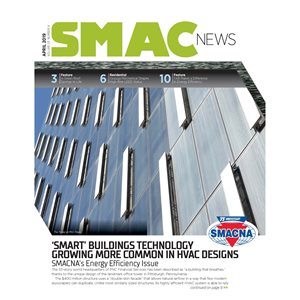University Innovation Center Designed for Collaboration
The roof and façade design for a new academic building project created “the perfect blend of high-tech and natural esthetics” for the University of Maryland’s new Brendan Iribe Center for Computer Science and Engineering, according to Scott Callaway

Brendan Iribe Center auditorium.
The roof and façade design for a new academic building project created “the perfect blend of high-tech and natural esthetics” for the University of Maryland’s new Brendan Iribe Center for Computer Science and Engineering, according to Scott Callaway of Overly Custom Metal Systems.
“We were chosen because the design for the building façade and cladding was fairly complex,” said Callaway, the company’s design services manager. “HDR Architects reached out to us for pre-construction assistance. We have a history of experience with complex roofing projects and have done jobs with HDR in the past.”

Installing roof panels.
SMACNA contractor Overly Custom Metal Systems of Greensburg, Pennsylvania, fabricated the aluminum sheet metal panels that clad the auditorium roof, walls and vestibule enclosures of the new center for innovation at the University of Maryland-College Park. The rooftop panels give the center a modern yet traditional look. The center was named for the university alumnus who founded the virtual reality company Oculus VR.
The center includes labs for virtual reality, augmented reality, robotics and artificial intelligence, and is intended to spark innovation through collaboration. It is meant to be “a hub for technology at the heart of a new innovation district, among high-tech companies, government agencies and institutional colleagues,” according to the university.
The 215,600-square-foot, six-story building serves about 620 regular occupants and can accommodate more than 4,000 individuals during peak usage. The center includes these features:
- 5,300 square feet of collaborative makerspace
- 785 seats of instructional space
- 13 computer labs, including virtual and augmented reality labs
- Eight classrooms and five seminar rooms
- 20,000 square feet of community space
- A 300-seat auditorium
Expanding interest in computer science and engineering, both current and anticipated, meant that the university needed a single facility for those offerings.
“We supplied our Batten Type B (raised batten) and FLP (flat lock) panel systems, fabricated from 18-gage .040 inch painted aluminum,” Callaway said. “We finished the panels using the Overly Vintage Series painted metal finishes, which provide a beautifully weathered look without rust runoff or staining the surrounding material on and around the building.” The sleek auditorium roof projects the appearance of natural copper.
These products, Callaway said, “are a combination of a high-tech, modern look that combine with a rich historical or rustic appeal by blending natural materials.”
The “greatest hurdle” for the client, he said, was the financial decision in choosing the right finish for the budget. The client originally wanted copper, but that exceeded the budget and mandated a change in materials. “We introduced them to our painted metal option,” Callaway said. “It’s a two-color print process.”
While there were no major technical challenges, fabrication was driven in large part by the building information model (BIM). “BIM helps with potential conflicts between trades in design changes; it helps resolve problems before they occur on-site,” Callaway noted. “The general contractor served as the BIM manager and all the manufacturers fed models of their work for complete integration.”
Overly’s part of the project was about $325,000, with raw materials representing nearly 45 percent of that cost. “We didn’t do installation, but about 15 Overly workers were involved in pre-construction, estimating, design, operations, fabrication and on-site assistance,” Callaway explained.
“We’re very proud of the look. Our specialty paint sets it apart,” Watkins continued. “When you look away from the drawings and see the finished version, it gives you a burst of energy. You can feel a breath of fresh air.”
This project, Callaway said, “is proof that if you’re willing to change with the times, you can present an esthetically pleasing project that performs well.”
Published: April 29, 2019
IN THIS ISSUE
‘Smart’ Buildings Technology Growing More Common in HVAC Designs
Energy efficiency is not just about the environment, its about smart business. This Energy Efficiency Issue covers a myriad of energy efficient projects including Pittsburgh’s groundbreaking PNC Tower – and SMACNA contractors were there to bring it
A Green Roof Springs to Life
On top of a pharmaceutical company’s parking garage in Wilmington, Delaware, there grows a thriving patch of countryside, courtesy of SMACNA member Ernest D. Menold Inc.
Canadian Firm Revamps Plant Exhaust System
Trade-Mark Industrial Inc. of Cambridge, Ontario is flourishing in Canada’s booming economy. Trade-Mark has approximately 1,200 men and women in the field in locations as far west as Manitoba and the United States.
Developing Leaders Through Feedback
Collectively, companies spend billions of dollars for leader development, utilizing everything from public seminars to executive MBA programs at prestigious universities. While all of these have value, people sometimes overlook one of the simplest
Geauga Mechanical Contributes to Luxury High-Rise’s LEED Status
Expertise in energy efficiency and early involvement in the planning process were the keys to a successful residential – and landmark – project for Geauga Mechanical of Chardon, Ohio, according to CEO Craig Berman, LEED AP, CEM.
President’s Column: Building on the Benefits of Energy Efficiency
Today’s emphasis on energy management provides contractors with several opportunities to expand their businesses and help buildings become more energy efficient.
San Diego Crime Lab Requires Complex Systems
Associate Mechanical Contractors' complex HVAC system for the San Diego county Crime Lab helped it achieve LEED-Gold status.
SMACNA Endorses Bipartisan Bill to Speed Hospitality Retrofits
SMACNA has enthusiastically expressed support for the bipartisan bill, Restoring Investments in Improvements Act of 2019 (S. 803), which would amend last year’s Tax Cuts and Jobs Act to boost renovations and retrofits for restaurants and retailers.
Solar Power Harnesses the Sunshine
Roofs can serve multiple purposes besides being the foundation for green roofs. Harnessing the power of the sun, for instance, as a solar energy source for buildings and homes. Some SMACNA contractors are venturing into the solar market, offering
Testing and Balancing: Making a Difference in Energy Efficiency
SMACNA’s testing, adjusting, and balancing contractors are expanding their businesses by focusing on building systems and helping building owners and operators utilize their HVAC systems more efficiently.
University Innovation Center Designed for Collaboration
The roof and façade design for a new academic building project created “the perfect blend of high-tech and natural esthetics” for the University of Maryland’s new Brendan Iribe Center for Computer Science and Engineering, according to Scott Callaway


